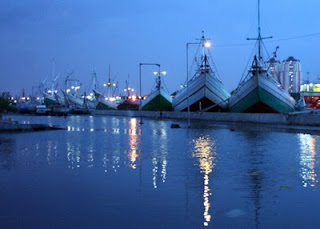 |
| Sunda Kelapa in The Evening |
The history of the city is closely connected with the port city of Sunda Kelapa as their origins. Port city in the Bay of Jakarta, the Ciliwung river estuary, is a very important trading center since the 12th century until the 16th century. At that time the port was already known as a busy port of pepper last Hindu kingdom in West Java, Pajajaran, located near the city of Bogor now. Foreign ships coming from China, Japan, South Indian, and Arabic is already docked at the port carrying goods such as porcelain, coffee, silk fabrics, perfumes, horses, wine, and dyes in exchange for spices the wealth of the homeland at that time.
Portuguese first Europeans first arrived in Sunda Kelapa in 1512 to seek opportunities spice trade with the western world. Their presence did not last long, after the combined strength of Banten and Demak Muslim, Sunan led Gunungjati (Fatahillah), master of Sunda Kelapa and changed its name to White Rose ("a real victory") dated June 22, 1527.
After the Portuguese leave, Dutch traders arrived in 1596 with the same goal, looking for spices. Spices are very sought after commodity at the time and become lux in the Netherlands because of various properties such as medicine, body warmers, perfumes and ingredients. Dutch traders (who later joined in VOC) initially received a warm welcome from Prince Wijayakrama and make an appointment.
However, tempted by the potential for high revenue from the sale of spices in their home country, VOC deny the agreement and established the fort in the southern port of Sunda Kelapa. The fort was, in addition to functioning as a warehouse storage of goods, also used as a stronghold of resistance from British forces also intend to control trade in the archipelago.
The fort was built in 1613, approximately 200 meters to the south port of Sunda Kelapa. In 1839 the site was founded Tower Syahbandar that serves as a customs office, or collection of taxes from the goods unloaded at the port. The location of this tower occupies one of the bastions (corner of the fort) is left.
Approximately 50 meters to the west of the tower there is the Maritime Museum. In this museum can be seen in the original equipment, replicas, drawings and photographs relating to the marine world in Indonesia, ranging from the royal era up to modern expeditions. The museum is actually occupying the building warehouses to store goods VOC trade in 17th and 18th centuries, and still maintained its original condition for tourism activities. Even part of the building can be rented for private events. On the north side of the museum still have the original fort that became the northern stronghold.

No comments:
Post a Comment